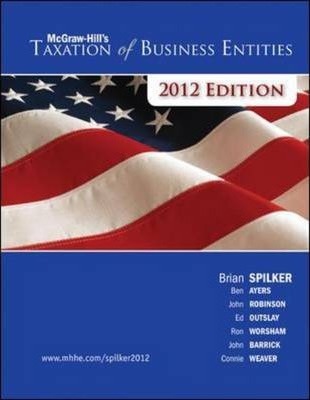
McGraw-Hill's Taxation of Business Entities 3rd Edition by Connie Weaver, Brian Spilker, Edmund Outslay, John Robinson, Ronald Worsham, Benjamin Ayers, John Barrick
Edition 3ISBN: 9780077924522
McGraw-Hill's Taxation of Business Entities 3rd Edition by Connie Weaver, Brian Spilker, Edmund Outslay, John Robinson, Ronald Worsham, Benjamin Ayers, John Barrick
Edition 3ISBN: 9780077924522 Exercise 33
Rondo and his business associate, Larry, are considering forming a business entity called R L but they are unsure about whether to form it as a C corporation, an S corporation or as an LLC. Rondo and Larry would each invest $50,000 in the business. Thus, each owner would take an initial basis in their ownership interest of $50,000 no matter which entity type was formed. Shortly after the formation of the entity, the business borrowed from the bank $30,000. If applicable, this debt is shared equally between the two owners.
a. After taking the loan into account, what is Rondo's tax basis in his R L stock if R L is formed as a C corporation
b. After taking the loan into account, what is Rondo's tax basis in his R L stock if R L is formed as an S corporation
c. After taking the loan into account, what is Rondo's tax basis in his R L ownership interest if R L is formed as an LLC
a. After taking the loan into account, what is Rondo's tax basis in his R L stock if R L is formed as a C corporation
b. After taking the loan into account, what is Rondo's tax basis in his R L stock if R L is formed as an S corporation
c. After taking the loan into account, what is Rondo's tax basis in his R L ownership interest if R L is formed as an LLC
Explanation
a)
For C Corporations, the debt of the e...
McGraw-Hill's Taxation of Business Entities 3rd Edition by Connie Weaver, Brian Spilker, Edmund Outslay, John Robinson, Ronald Worsham, Benjamin Ayers, John Barrick
Why don’t you like this exercise?
Other Minimum 8 character and maximum 255 character
Character 255


